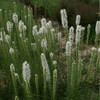
Liatris spicata 'Floristan White' - DENSE BLAZING STAR 'FLORISTAN WHITE'
'Floristan White' is a white-flowering cultivar of dense blazing star. This favorite, easy to grow, and very showy perennial has narrow leaves that gradually decrease in size and length towards to top of the stems, which continue in 10" long spikes of purple-red flowers that highly attract bumblebees, long-horned bees, leaf-cutting bees, butterflies, and skippers. The flowers appear from mid to late summer, and the fluffy seeds that follow stay on the stems till early winter. It is clay tolerant and a good cut flower.
Unfortunately, this plant (especially the young shoots), is a tasty snack for deer and rabbits, and the corms can be eaten by voles. It may be difficult to establish in areas where these animals are overpopulated.
Brings wonderful verticality to plantings and can be combined with many common perennials like daylilies (Hemerocallis), Echinacea, Heliopsis, Rudbeckia, Monarda, or grasses, or annuals like zinnias.
Other common names include blazing star, dense blazing star or marsh blazing star or gayfeather.
Picture copyright : US Perennials nursery
Blooming Time: July to August
Size: 3' tall x 0.75' wide
USDA Zones: 3 to 8
Culture: full sun, average soils (adaptable to soil type and moisture)
Moisture Needs: medium-dry, moist, or wet
Origin: the wild species of L. spicata is a wildflower that's native to eastern North America (USDA distribution map)
Deer/Rabbit Resistant: no / no
Attracts Butterflies or Pollinators: yes / yes
Attracts Hummingbirds: no
Pot Size: square 3.5" x 4" deep perennial pot

Liatris spicata 'Floristan White' - DENSE BLAZING STAR 'FLORISTAN WHITE'
'Floristan White' is a white-flowering cultivar of dense blazing star. This favorite, easy to grow, and very showy perennial has narrow leaves that gradually decrease in size and length towards to top of the stems, which continue in 10" long spikes of purple-red flowers that highly attract bumblebees, long-horned bees, leaf-cutting bees, butterflies, and skippers. The flowers appear from mid to late summer, and the fluffy seeds that follow stay on the stems till early winter. It is clay tolerant and a good cut flower.
Unfortunately, this plant (especially the young shoots), is a tasty snack for deer and rabbits, and the corms can be eaten by voles. It may be difficult to establish in areas where these animals are overpopulated.
Brings wonderful verticality to plantings and can be combined with many common perennials like daylilies (Hemerocallis), Echinacea, Heliopsis, Rudbeckia, Monarda, or grasses, or annuals like zinnias.
Other common names include blazing star, dense blazing star or marsh blazing star or gayfeather.
Picture copyright : US Perennials nursery
Blooming Time: July to August
Size: 3' tall x 0.75' wide
USDA Zones: 3 to 8
Culture: full sun, average soils (adaptable to soil type and moisture)
Moisture Needs: medium-dry, moist, or wet
Origin: the wild species of L. spicata is a wildflower that's native to eastern North America (USDA distribution map)
Deer/Rabbit Resistant: no / no
Attracts Butterflies or Pollinators: yes / yes
Attracts Hummingbirds: no
Pot Size: square 3.5" x 4" deep perennial pot









